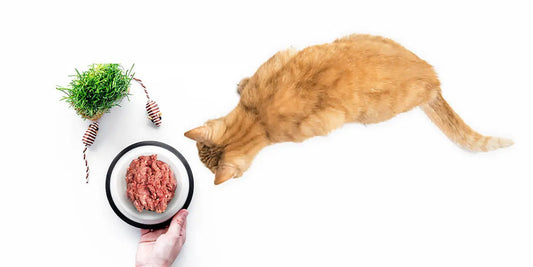
Is Fresh / Raw Dog Food Better Than Kibble?
As a human, you know that fresh, whole foods are filled with the vitamins and minerals your body needs to thrive. In fact, as the benefits of fresh foods have become increasingly clear, countless people have revamped their diets and reaped the rewards.
Yet many of our beloved canines continue to dine on kibble—dry food that endures heavy processing.
As a pet parent, you only want the best for your dog, and that includes the best diet—one that’ll help them thrive for years of walks, play dates, and late-night cuddles. This begs the question: Is fresh dog food better than kibble?
Fresh dog food does indeed deliver benefits above and beyond those offered by processed dry food. Let’s talk about how it eclipses kibble, and how to successfully make the change.
Why Choose Fresh or Raw Dog Food Over Kibble?
While kibble may seem like the standard diet for dogs, it wasn’t always. Evidence indicates that humans first befriended dogs around 30,000 years ago, and throughout the millennia, these domesticated dogs simply dined on leftovers or set-aside portions from human tables.
Since processed food (for both people and dogs) didn’t emerge until the early 1800s, dogs would have relied (and thrived) on fresh food for the majority of their time by humanity’s side. And much of this fare would have fallen in line with dogs’ ancestral diet (i.e. fresh meat).
While kibble offers convenience, it’s definitely a shift away from natural canine feeding habits. Since an ancestral diet fueled dogs’ evolution, there’s good reason to believe it still offers exceptional nutritional benefits.
Key Differences Between Fresh/Raw, and Kibble
So, what sets kibble apart from raw food? It mainly boils down to processing. While kibble contains many naturally source ingredients, manufacturing removes much of their nutritional benefit.
Let’s take a closer look at how raw food and kibble compare:
-
Raw food consists of uncooked, minimally processed foods. Meat and organ tissue feature heavily, accompanied by dog-friendly vegetables, eggs, and some dairy. Raw food comes in multiple forms, including frozen and dehydrated options. Since they incorporate fresh ingredients, raw diets usually require a bit of prep/cleanup. This includes slicing/deboning meat and washing veggies. Learn more about the different types of dog food.
-
Kibble refers to mass-produced puppy chow manufactured by boiling down a mixture of ingredients (like meat, veggies, and grains like corn and wheat). Machines then shape this blend into tiny spheres and spray it with brown dye. Unlike raw food, kibble comes ready to eat. You simply pour it into a bowl and let your pups go to town.
Ease of use plays a major role in kibble’s popularity. However, to manufacture en masse, many kibble brands rely on subpar ingredients and employ unhealthy filler and binding agents.
Kibble may also pick up trace remnants of other products produced in the same facility, many of which have nothing positive to offer dogs.
Health Benefits of Fresh and Raw Dog Food
So, is raw dog food better than kibble? You could say the benefits speak for themselves.
Dogs who eat a raw food diet generally enjoy:
-
Sleek coats and vibrant fur
-
Healthy skin
-
Elevated energy levels
-
Solid (and less smelly) stools
-
Clean teeth
-
Enhanced gut function
Since dogs carry carnivore DNA, a diet rich in raw meat pairs well with their digestive tract, exercises their jaw, and offers a primal satisfaction that kibble lacks.
Raw food also packs ample moisture compared to kibble. This extra water helps keep your pup hydrated and assists with digestion. What’s more, many dogs don’t drink enough water, so receiving some supplemental hydration during mealtimes can elevate their overall health.
Raw diets also include far fewer carbohydrates than kibble-based diets. This helps keep the pounds off pups inclined to hefty physiques.
How to Transition Your Dog to Fresh or Raw Food
When you discover the benefits, it’s natural to consider eliminating kibble from your pup’s diet in favor of raw, natural fare. After all, your dog brings so much joy to your life—you want to return the favor any way you can.
But the prospect of a diet switch can feel a little daunting. You may have questions like:
-
Where do I start?
-
What if my pup doesn’t like raw food?
-
Can I dedicate enough time to prep?
Fortunately, we’re here to help. By taking a measured, patient, and well-informed approach, you can easily transition your dog’s diet.
Step-by-Step Guide to Switching
The key to smoothly transitioning your dog’s diet is to take it slow. A sudden shock to the system won’t help your pup’s health, and it may prolong the transition.
Instead, plan on a gentle and gradual shift. Pay close attention to your pup’s reactions to their new food, and note any changes in behavior.
Ideally, you want to plan for a 10-day transition period.
Once you have high-quality raw dog food on hand, follow these steps:
-
Begin by offering your pup a mixture of 75% kibble and 25% raw food. Do this for three days.
-
Increase the raw food portion (up to around 50%) for days 4-6.
-
Up the fresh fare to 75% on days 7-10.
-
Completely eliminate kibble following day 10.
Of course, this schedule represents a general guideline. If your pup turns up his nose or eats around the raw food, you may have to spend longer in the early stages as they get used to the fresh additions. Just practice patience and give them time to come around.
When transitioning, try to maintain stability. Stick to a regular feeding schedule—ideally, the same routine you kept during the kibble stage.
-
Dogs on regular feeding rhythms get used to eating at the same time every day, so their appetite stirs at meal times.
-
Unlike kibble, raw food can’t sit out for hours, so you want to ensure your pup will be hungry when you serve it.
-
An ideal daily routine is to feed once in the morning and once in the evening (and go light on treats in between meals).
Keeping the rest of your dog’s routine steady will also help minimize the shock of a diet change. So, do your best to stick to your regular schedule of walks, playtime, and cuddles.
Helping Picky Eaters
Let’s face it: Some pups are just plain picky. If you’re worried your choosy canine won’t bite when it comes to raw food, you can try a few approaches to help them relax and enjoy their fresh fare:
-
Serve meals in a quiet, low-traffic area of your home. Some dogs refuse to eat when they’re overstimulated.
-
Hand-feed them when starting the transition. Your scent and comforting touch may prove reassuring to a skittish pup.
-
Heat the raw food before serving it. While there’s no need to fully cook your dog’s meals, a gentle saute beforehand can produce enticing aromas.
When beginning the transition, you can also spice up your raw food by sprinkling a treat or two into the mix, like some tasty freeze-dried chicken hearts or beef liver dog treats.
Above all, remember—no two dogs are alike. Some may take to their new diet from the get-go, while others may require greater patience and attention. Temporary digestive issues may also arise for some pups, while others enjoy a smooth transition.
At the end of the day, don’t feel discouraged if your pup takes a while to transition to a raw food diet. Stay patient, and offer encouragement during meals. In time, your dog will benefit from a fresh, flavorful raw food diet.
Is Kibble Still a Good Option for Your Dog?
While kibble doesn’t offer as much as raw food in the way of health benefits, it nevertheless comes with some potential pros, including:
-
Convenience – Ready-to-eat kibble takes less time to prepare.
-
Low cost – Mass-produced kibble features a minimal price tag compared to many fresh options. (As the saying goes, you get what you pay for.)
-
Balance – Kibble comes formulated with a wide array of essential nutrients, and dogs who eat it receive a balanced nutritional profile.
-
Extended shelf-life – Perhaps its biggest benefit, kibble stays edible for months (if not years), making for simple storage and travel-ready feeding.
There are also a wide variety of kibble brands to choose from. While some of them rank low on nutrients and high on artificial fillers, others undergo more conscientious processing and offer a better nutrient mix. If you do choose to feed your dog kibble, take time to research the brand, its reputation, and its ingredients to ensure a high-quality option.
Overall, dogs thrive when their diet aligns with that of their ancestors: raw, unprocessed, and grain-free. While kibble may adequately fuel daily life, fresh fare unlocks another level of canine health.
Why Darwin's Natural Pet Products is a Top Choice for Raw Dog Food
Switching your pup from kibble to raw dog food can transform their health and energy. If you’re ready to begin the transition, Darwin’s Natural Pet Products can offer a helping hand. Our Natural Selections fresh dog food provides a premium blend of natural ingredients your dog will love—think free-range meats and pure, unprocessed veggies.
What’s more, all of our offerings are free of steroids, antibiotics, and hormones. Plus, they’re easily prepped and portioned, making the transition process simple and enjoyable for pets and pet parents alike.
Help your dog connect with their ancestral spirit with a wholesome raw food diet. Discover Darwin’s today.
Sources:
-
Boehringer-Ingelheim. The human-dog relationship – a historical perspective. https://www.boehringer-ingelheim.com/animal-health/our-responsibility/human-dog-relationship-historical-perspective
-
Wild Health. Everything to Know About the Rise of Processed Foods in the United States. https://www.wildhealth.com/blog/everything-to-know-about-the-rise-of-processed-foods-in-the-united-states
-
PetMD. A Guide to Dog Food Ingredients and Reading Dog Food Labels. https://www.petmd.com/dog/nutrition/pet-food-ingredient-and-label-guide
- WebMD. Raw Dog Food: Dietary Concerns, Benefits, and Risks. https://www.webmd.com/pets/dogs/features/raw-dog-food-dietary-concerns-benefits-and-risks


